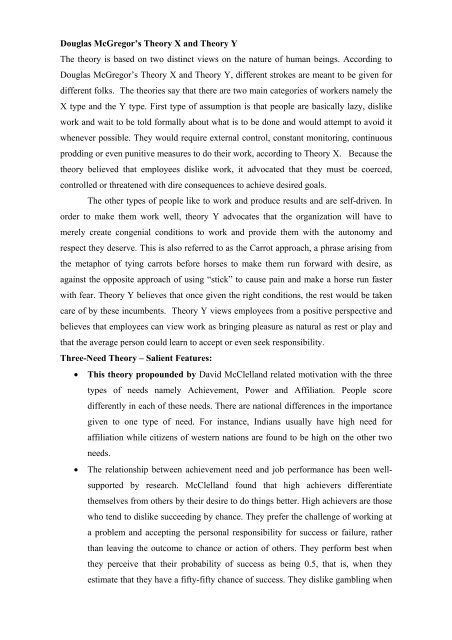UNIT – I Lesson 1 HRM – AN OVERVIEW Lesson Outline Nature of ...
UNIT – I Lesson 1 HRM – AN OVERVIEW Lesson Outline Nature of ...
UNIT – I Lesson 1 HRM – AN OVERVIEW Lesson Outline Nature of ...
You also want an ePaper? Increase the reach of your titles
YUMPU automatically turns print PDFs into web optimized ePapers that Google loves.
Douglas McGregor’s Theory X and Theory Y<br />
The theory is based on two distinct views on the nature <strong>of</strong> human beings. According to<br />
Douglas McGregor’s Theory X and Theory Y, different strokes are meant to be given for<br />
different folks. The theories say that there are two main categories <strong>of</strong> workers namely the<br />
X type and the Y type. First type <strong>of</strong> assumption is that people are basically lazy, dislike<br />
work and wait to be told formally about what is to be done and would attempt to avoid it<br />
whenever possible. They would require external control, constant monitoring, continuous<br />
prodding or even punitive measures to do their work, according to Theory X. Because the<br />
theory believed that employees dislike work, it advocated that they must be coerced,<br />
controlled or threatened with dire consequences to achieve desired goals.<br />
The other types <strong>of</strong> people like to work and produce results and are self-driven. In<br />
order to make them work well, theory Y advocates that the organization will have to<br />
merely create congenial conditions to work and provide them with the autonomy and<br />
respect they deserve. This is also referred to as the Carrot approach, a phrase arising from<br />
the metaphor <strong>of</strong> tying carrots before horses to make them run forward with desire, as<br />
against the opposite approach <strong>of</strong> using “stick” to cause pain and make a horse run faster<br />
with fear. Theory Y believes that once given the right conditions, the rest would be taken<br />
care <strong>of</strong> by these incumbents. Theory Y views employees from a positive perspective and<br />
believes that employees can view work as bringing pleasure as natural as rest or play and<br />
that the average person could learn to accept or even seek responsibility.<br />
Three-Need Theory <strong>–</strong> Salient Features:<br />
• This theory propounded by David McClelland related motivation with the three<br />
types <strong>of</strong> needs namely Achievement, Power and Affiliation. People score<br />
differently in each <strong>of</strong> these needs. There are national differences in the importance<br />
given to one type <strong>of</strong> need. For instance, Indians usually have high need for<br />
affiliation while citizens <strong>of</strong> western nations are found to be high on the other two<br />
needs.<br />
• The relationship between achievement need and job performance has been wellsupported<br />
by research. McClelland found that high achievers differentiate<br />
themselves from others by their desire to do things better. High achievers are those<br />
who tend to dislike succeeding by chance. They prefer the challenge <strong>of</strong> working at<br />
a problem and accepting the personal responsibility for success or failure, rather<br />
than leaving the outcome to chance or action <strong>of</strong> others. They perform best when<br />
they perceive that their probability <strong>of</strong> success as being 0.5, that is, when they<br />
estimate that they have a fifty-fifty chance <strong>of</strong> success. They dislike gambling when
















